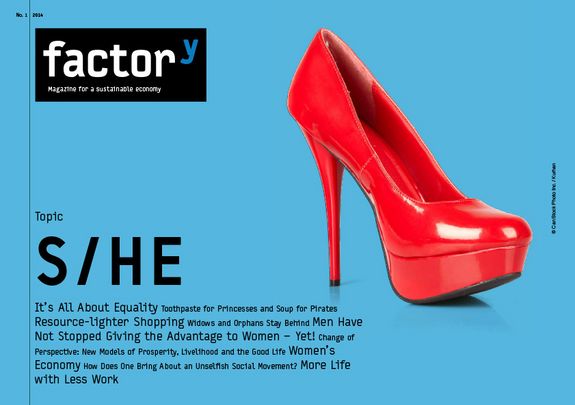Gender

Toy industries and food and clothing sectors specifically address children with gender-specific colours and contents. So-called gender-marketing strongly boosts consumption and often forces parents to involuntarily buy products which they themselves do not really like.
By Astrid Herbold
Translated from the German by Marina Nikic, Katharina Lopes Duarte
If it were up to my five-year-old son, everything we buy would be covered in logos. We would have a Capt’n Sharky lunch box, a Star Wars drinking bottle and Spider Man bed sheets. His yoghurt is already decorated with Vicky the Viking, his sandals have dinosaur teeth and he has Cars-themed slippers. His friends in kindergarten are the same: merchandising products have a huge impact on children. Everyone wants them and everyone has the same. Shopping with your children always ends in an argument. Children consistently choose the ‘branded’ products and specifically those which appeal to their gender. As you may know, our sons and daughters live in two different worlds. Three-year-olds are already aware of which products are intended for them. Red stripes on shoes mean: ugh, girls stuff! A blue backpack: yuck, that’s for boys! Where does this early manifestation of such strict gender stereotypes come from?
The man who has the answer to this question is Axel Dammler, the managing director of the research institute iconkids & youth in Munich. He helps companies with advertising campaigns that are specifically tailored for children. He has worked with big companies such as Lego, Ferrero and Nestlé. It is therefore no surprise for Dammler that a child who cannot yet read can nevertheless recognise the Star Wars typeface on a chocolate surprise egg at the supermarket: “Just like adults, children react to key signals such as, for example, certain colour codes, but also typography, pictures and symbols.”
Children recognise fonts and colour codes
But how does a boy know that he is only supposed to react to ‘male’ products? Dammler thinks that children acquire this kind of knowledge incidentally, through the things they experience. In the first years of their lives, everything that surrounds children merges into a big picture: the colours and logos on their clothes, the layout of food packaging, the toys in their rooms, the things they see on posters, on television, in catalogues or magazines. The industry uses this process in order to direct attention to their products. This mechanism works because young children feel a strong need to identify themselves in regard to gender and social position. Dammler sees no reason to worry. In his opinion, this behaviour has biological roots and finding one’s own identity starts with a rudimentary differentiation of gender roles.
Stevie Schmiedel gets upset when she hears expressions like ‘biological roots’. In 2012, the PhD gender researcher from Hamburg founded the organisation ‘Pinkstinks Germany’, which fights vehemently against ‘limiting‘ gender roles, as she calls it.
“Children are born and quickly learn that in our society it is of major importance what sex you are and how well you embody that role.” This is why even the youngest of them try to find clues on how they can belong. From a capitalist point of view, Schmiedel can understand why the industry ‘genders’ products in order to raise profits but from an emancipatory standpoint, she finds it very worrisome: “There are two versions of everything. There are crisps for him and her; there is instant soup for racing drivers or princesses as well as toothpaste for girls and toothpaste for boys.”
Then it's better to buy something new
This pressures families into consumerism. Schmiedel says that everything has to be bought twice, which is very nerve wracking. She explains that this trend has made it to the children’s rooms. “Monopoly, Scrabble, Memory, there is no game or toy that doesn’t exist in duplicate.” Although many parents are critical towards gender marketing, children still manage to get their way. “Parents don’t want their kids to be bullied,” Schmiedel says. Little sisters rarely inherit the things their big brothers have used before. Parents prefer to buy new things that are gender appropriate. Schmiedel knows that marketing managers are aware of that and work according to the motto: Children need it and they want it – although most of the time, they simply try not to be excluded from their peer group.
Pinkstinks rigorously fights against this subliminal group pressure. Schmiedel and her team are part of a global initiative. Pinkstinks has been active in England for six years. Founders Abi and Emma Moore fight against toymakers whose offers for girls only include makeup sets, toy vacuums and glittery knick-knack. In Australia, the initiative TowardTheStars works towards the deconstruction of female stereotypes in children’s rooms. In the USA, there is a princess-free zone. The heroine of the website is called Super Tool Lula and is the female equivalent to Bob the Builder.
The German organisation mainly focuses on publicity. It has repeatedly put several companies in the hot seat and its famous Facebook shitstorms are widely feared today. Recently, Pinkstinks was outraged by push-up bras – for seven-year-olds. In addition, Pinkstinks started a petition against pink chocolate surprise eggs.
Stevie Schmiedel and her team also participated in protests against the opening of the ‘Barbie Dream House’ in Berlin. For them, everything that the Barbie doll and her skinny and goggle-eyed relatives stand for is exactly the opposite of female emancipation. Schmiedel provocatively states that identifying with Princess Lillifee and Barbie is the first step to accepting a salary that is 22% lower than that of one’s future male colleagues.
Protests against bras for children and sexist advertising
Schmiedel is not only worried about gender marketing but also about the general depiction of women in commercials. She thinks that the image of women in our society humiliates and degrades them. She partly blames poster campaigns that have become increasingly obscene. “Twenty years ago, the lingerie pictures that H&M spread all over Germany in 2012 would have been considered pornography. Nowadays it’s called eroticism.”
Although one can find androgynous beauty ideals on international catwalks, even if loose boyfriend jeans sell extremely well among women at the moment and single designer labels hit the headlines with their stylish unisex collections, Schmiedel thinks that the trend is still mainly going in the other direction. What had started as a sales pitch for children is slowly affecting more and more adults, too. Schmiedel explains that there are already pink power drills for women as well as pink toolboxes. There is pink beer, pink champagne as well as pink sausage for women because it contains less fat and has a milder taste. Although many clients make fun of all those things, companies still make large profits with those products. It seems in fact that adults also like to buy things with packaging that serves the gender cliché.
Astrid Herbold obtained a doctorate working on the topic of gender metaphors. Today, she is a freelance writer and journalist in Berlin. Herbold, a mother of three, published M. o. M. – Mütter ohne Mann (mothers without a partner) in 2006. It was republished as Wir sind Heldinnen (we are heroines) in 2012. Astrid Herbold writes regularly for the German newspapers Tagesspiegel, Zeit Online, Das Magazin etc.
More articles on the topics of gender relations and sustainability you will find not only online but in our magazine S/He to download. The PDF-magazine is finely illustrated and good readable on tablets and screens and it contains all articles and pictures including numbers and quotations on topic.
Beiträge online
GENDER

- It is about equality
- Toothpaste for Princesses and Soup for Pirates
- Men Have Not Stopped Giving the Advantage to Women – So Far
- Resource-light shopping
- Perspektivenwechsel: Neue Wohlstandsmodelle, Livelihood und Gutes Leben
Themen
- The Domino Effect: the Mobility Transition as an Engine for the ‘Great Transformation’
- Cities Use the Space
- Decarbonization by 2030
- The fear of biting the hand that feeds you
- Where investing is a pleasure
- Why divestment is going to change the world
- A Robin Hood tax for climate protection
- May the Force Be with Us
- Modern Strategies
- The prerogative of interpreting the future now lies with the companies involved in climate protection”
- From Negotiating to Trading Equitably
- Can a donkey be tragic?
- Rethink rather than rebound: a sufficiency revolution must precede the efficiency revolution
- On Rebound, Prebound and Performance Gaps
- So Let Us Seize Power Then!
- With Common Property Against Political Failure
- So Let Us Seize Power Then!
- The Comforting Beauty of Failure
- “It Is Not Impossible at All.“
- Resource-light shopping
- Men Have Not Stopped Giving the Advantage to Women – So Far
- Toothpaste for Princesses and Soup for Pirates
- It is about equality
- A nice day
- Initiative instead of frustration
- The right ingredients
- Resilient for Life
- Not only, but also
- Appreciation – more please!
- Worth more than money
- Learning to value the value of goods
- Worth and Values
- The Transformative Power of Science
- Historically effective: How innovation and technology transform
- The Disappearance of Products
- Growing Older 101
- Columbus’ Egg
- It Works! In Theory at Least ...
- What If...?
- Analysing Separately – Thinking and Acting Together!
- Let’s Break Away from Determined Breaking Points
- More Gold in Waste than in Mines
- The art of separation
- Should you really DIY?
- The Aesthetics of Do-It-Yourself
- Standing on One’s Own Feet
- From the handaxe to desktop fabrication
- Using Shares to Survive the Crisis
- When Citizens participate
- Possess to Participate
- The Right Growth at the Right Time
- Gunter Pauli and Blue Economy
- When Sustainability Grows
- How we treat Growth
- Illusions about Growth


